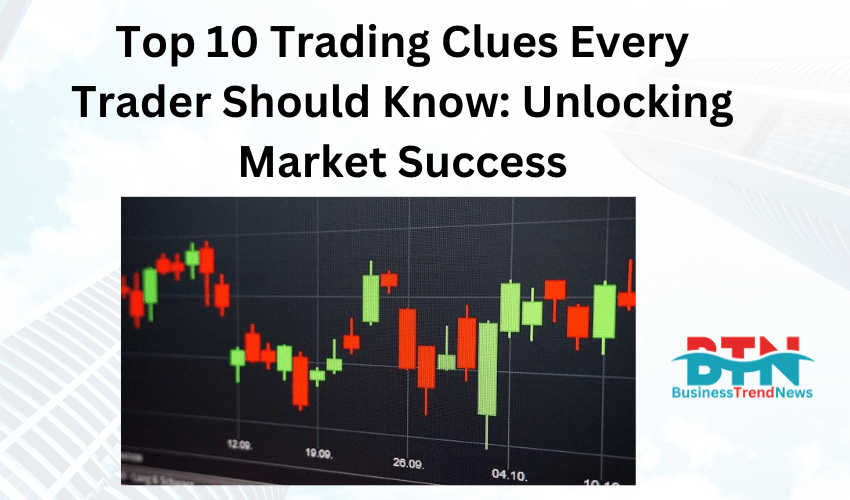![]()
Trading in financial markets can be a highly profitable venture, but it requires more than just luck or intuition. To succeed, traders need to develop a keen sense of market behavior, which comes from understanding key trading clues. These clues are insights or indicators that can help traders make informed decisions, reducing risk and increasing the potential for profit.
In this article, we’ll delve into the top 10 trading clues that every trader, from novice to experienced, should know. By understanding and leveraging these clues, you’ll be better equipped to navigate the complexities of the financial markets.
1. Trend Identification: Follow the Market’s Flow
One of the most fundamental principles in trading is the concept of trend identification. A trend is the general direction in which the market is moving, and identifying it early can give traders a significant advantage.
- Uptrend: Characterized by higher highs and higher lows, indicating a bullish market where prices are expected to rise.
- Downtrend: Defined by lower highs and lower lows, signaling a bearish market with declining prices.
- Sideways or Range-Bound Market: When the market moves within a horizontal range, with no clear uptrend or downtrend.
Clue: Use moving averages, trendlines, and the Relative Strength Index (RSI) to confirm the trend direction. Combining these tools can help you identify the prevailing trend and avoid trading against it.
2. Support and Resistance Levels: The Market’s Boundaries
Support and resistance levels are critical in understanding market psychology and price behavior.
- Support: A price level where a downtrend is expected to pause due to a concentration of buying interest.
- Resistance: A price level where an uptrend is expected to pause due to a concentration of selling interest.
Clue: Look for price action near these levels. A break above resistance or below support could signal a continuation of the trend, while a bounce could indicate a reversal.
3. Volume Analysis: The Power Behind Price Movements
Volume refers to the number of shares or contracts traded in a security or market during a given period. It’s an essential clue for understanding the strength behind price movements.
- High Volume: Often confirms the validity of a price move. For instance, if a stock breaks out of resistance on high volume, the move is more likely to be sustainable.
- Low Volume: May indicate a lack of conviction among traders, suggesting that a price move could be short-lived.
Clue: Use volume indicators like the On-Balance Volume (OBV) or Volume Oscillator to gauge the strength of price movements. Rising volume on uptrends and declining volume on downtrends are positive signs.
4. Candlestick Patterns: Reading the Market’s Mind
Candlestick patterns are visual representations of price movements and are packed with information about market sentiment.
- Bullish Patterns: Such as the Hammer or Engulfing patterns, indicate potential upward reversals.
- Bearish Patterns: Like the Shooting Star or Dark Cloud Cover, suggest potential downward reversals.
Clue: Familiarize yourself with key candlestick patterns and their meanings. Combining candlestick patterns with other indicators, like support and resistance, can increase their effectiveness.
5. Technical Indicators: Tools for Precision Trading
Technical indicators are mathematical calculations based on price, volume, or open interest that traders use to forecast future price movements.
- Moving Averages (MA): Smooth out price data to identify the direction of the trend.
- Relative Strength Index (RSI): Measures the speed and change of price movements to identify overbought or oversold conditions.
- Moving Average Convergence Divergence (MACD): Shows the relationship between two moving averages of a security’s price.
Clue: Use a combination of indicators to confirm signals. For example, if the RSI indicates overbought conditions and the MACD shows a bearish crossover, it could be a strong sell signal.
6. Economic Indicators: The Macro View
Economic indicators, such as GDP growth, employment rates, and inflation, can have a significant impact on market behavior.
- Interest Rates: Central bank interest rate decisions can influence market trends. Higher rates can strengthen a currency, while lower rates can weaken it.
- Employment Data: Strong employment figures usually indicate a healthy economy, which can boost market confidence.
- Inflation: Rising inflation can lead to higher interest rates, which may negatively impact stocks and bonds.
Clue: Keep an eye on the economic calendar and be aware of key data releases. Markets often react strongly to unexpected figures, so staying informed can help you anticipate potential price movements.
7. Risk Management: Protecting Your Capital
Risk management is arguably the most important aspect of trading. Without proper risk management, even the best trading strategy can lead to significant losses.
- Position Sizing: Determine the amount of capital to risk on each trade based on your overall portfolio and risk tolerance.
- Stop-Loss Orders: Set predetermined levels at which you will exit a trade to prevent further losses.
- Diversification: Spread your investments across different asset classes or markets to reduce risk.
Clue: Never risk more than you can afford to lose on a single trade. Using a fixed percentage of your trading capital per trade (e.g., 1-2%) is a good rule of thumb.
8. Market Sentiment: Gauging Investor Emotions
Market sentiment refers to the overall attitude of investors toward a particular security or the market as a whole. Sentiment analysis can help traders identify whether the market is bullish or bearish.
- Bullish Sentiment: Indicates that investors are optimistic, expecting prices to rise.
- Bearish Sentiment: Suggests that investors are pessimistic, anticipating a decline in prices.
Clue: Use tools like the Volatility Index (VIX) or sentiment surveys to gauge market sentiment. Extreme levels of optimism or pessimism can often precede market reversals.
9. News and Events: The Catalyst for Market Moves
News and events, such as earnings reports, geopolitical developments, or natural disasters, can cause sudden and significant market movements.
- Earnings Reports: Quarterly earnings announcements can lead to price volatility, especially if the results are better or worse than expected.
- Geopolitical Events: Events like elections, wars, or trade agreements can impact markets by influencing investor confidence.
- Natural Disasters: These can disrupt markets by affecting supply chains or damaging infrastructure.
Clue: Stay informed about current events and be aware of how they might impact your trades. News can be unpredictable, so be prepared to adjust your positions quickly if necessary.
10. Emotional Control: The Trader’s Mindset
Emotions can be a trader’s worst enemy. Fear and greed often lead to irrational decision-making, which can result in losses.
- Fear: Can cause traders to exit positions too early, missing out on potential profits.
- Greed: Can lead to overtrading or holding onto positions for too long, increasing the risk of losses.
- Impatience: Can cause traders to enter trades prematurely without proper analysis.
Clue: Develop a trading plan and stick to it. Having a set of rules for entry, exit, and risk management can help you stay disciplined and reduce the influence of emotions on your trading decisions.
Conclusion: Mastering the Art of Trading
Trading is as much an art as it is a science. By understanding and applying these top 10 trading clues, you’ll be better equipped to navigate the complexities of the financial markets. Remember, there’s no single clue or strategy that guarantees success; it’s the combination of various tools, techniques, and a disciplined approach that will help you achieve your trading goals.
Stay patient, keep learning, and continuously refine your approach to adapt to changing market conditions. With time and experience, these trading clues will become second nature, guiding you toward greater success in your trading journey.



